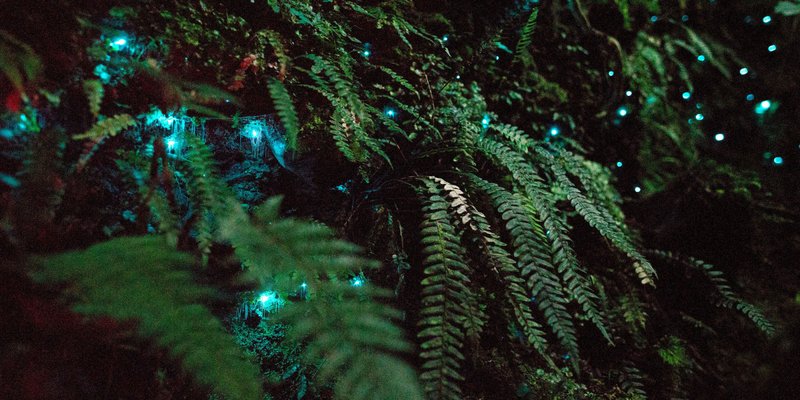
Mapping glow worm populations isn’t just for researchers, either. Anyone with a curious mind and a love for the outdoors can get involved, and you don’t need a background in science to start. Picture yourself on a serene forest trail, armed with a notebook and a flashlight, ready to embark on a journey of discovery. Let’s dive into how we can successfully map these enchanting creatures!
Understanding Glow Worms and Their Habitats
Before we jump into mapping, it’s essential to understand what glow worms are. Despite their name, glow worms aren’t actually worms; they’re the larvae of specific beetles, and they use bioluminescence to attract and catch food. Think of it like a natural fishing lure that glows in the dark! They’re typically found in damp, dark environments, like caves and forests, where they can safely hide from predators.
Glow worms thrive in humid conditions, often nestled under rocks or among damp leaves. This makes forest trails in moist areas ideal spots for spotting them. If you’re familiar with local wildlife, you might know that areas with plenty of decaying matter and a stable microclimate can support bigger populations. The key is to focus on locations that have rich organic material and minimal light pollution, which will allow you to see their glow distinctly.
Gathering the Right Tools for Mapping
To accurately map glow worm populations, you’ll need some basic tools. Here’s a quick checklist:
- Notebook: To record observations
- Flashlight: A dim, red light is best to minimize disturbance.
- Camera: To capture photos of glow worms and their habitats.
- GPS Device or Smartphone: Use it to mark locations.
- App for Recording Data: Several apps can track wildlife sightings.
Bringing along a friend can also make the experience more enjoyable and help you cover more ground. Just think about it: two pairs of eyes are better than one, especially when hunting for those elusive glowing larvae. Plus, sharing the adventure with someone else creates lasting memories!
Choosing the Right Time to Observe
Timing is everything when it comes to mapping glow worm populations. These little guys are most visible at night, often illuminated between dusk and midnight. It’s like a nightly show where they put on their best performance!
To maximize your chances, try visiting during warmer months, typically from late spring to early autumn. The temperatures should be conducive to their activity—warm, humid nights are ideal. If you’re wondering how you can determine the best nights, consider checking local weather forecasts for humidity levels or even consulting with local wildlife centers for guidance.
Mapping Techniques: Step by Step
Now let’s get into the nitty-gritty of mapping! Here’s a straightforward approach to help you collect the data you need:
1. Select Your Trail: Choose a forest trail known for glow worm sightings. It’s best to start in a familiar area.
2. Divide the Trail: Break the trail into segments. This helps to manage your observations and keeps the process organized.
3. Record Observations: As you walk, note the number of glow worms in each segment. Use your flashlight sparingly to avoid disturbing their environment.
4. Mark Locations: Use your GPS device or smartphone to mark where you find glow worms. A simple pin drop can help you remember exact spots for future visits.
5. Take Photos: Document your findings with photos! Not only is this useful for your records, but they can be valuable for sharing with other enthusiasts or scientists.
By following these steps, you can create a detailed map that offers insights into glow worm distribution. It’s like creating a glow worm treasure map!
Interpreting Your Data
Once you’ve gathered your observations, it’s time to make sense of the data. What trends do you notice? Are there specific areas with higher populations? You might find patterns related to environmental conditions like soil moisture, temperature, and proximity to natural features like streams or ponds.
Creating a simple chart can help visualize your findings, making it easier to spot trends. For instance, if one segment consistently shows more glow worms than others, it might indicate a healthier environment or better food availability. Share your discoveries with local conservation groups—they might find your work invaluable!
Why Mapping Matters
You might wonder why mapping glow worm populations is significant. Here’s the thing: understanding these populations can provide insights into the overall health of forest ecosystems. Glow worms are important indicators of environmental quality. Their presence or absence can signal changes in habitat conditions, potentially alerting conservationists to problems before they escalate.
Additionally, mapping efforts can contribute to wider scientific research. Your data may help track the effects of climate change, pollution, or habitat loss. So, every bit of information you gather can have a ripple effect, contributing to the preservation of these beautiful natural wonders.
Getting Involved in Conservation Efforts
If you find yourself captivated by glow worms and want to do more, consider getting involved in conservation efforts. Many organizations focus on preserving natural habitats, and they often welcome volunteers. You could participate in clean-up projects, help with habitat restoration, or assist in ongoing research initiatives.
Connecting with local wildlife groups can also keep you informed about future mapping opportunities or community science projects. Who knows? You might even inspire others to join the quest to protect these magical creatures!
In conclusion, mapping glow worm populations on forest trails is a rewarding adventure that offers both joy and insight into our natural world. Armed with a notebook, a flashlight, and a sense of curiosity, you can embark on a journey that not only deepens your connection to nature but also contributes to important conservation efforts. So, grab your gear and start exploring! Happy mapping!
